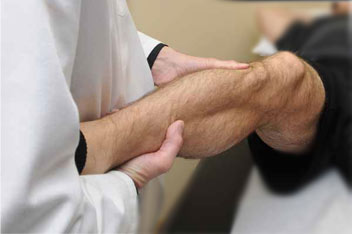Delay or ASAP?
 It’s a question we hear over and over here in the clinic. « How long should I wait, Doc, before signing on for knee replacement surgery? »
It’s a question we hear over and over here in the clinic. « How long should I wait, Doc, before signing on for knee replacement surgery? »
It’s a good question. The answer depends on each individual, his or her physical condition, age, lifestyle, and level of pain or disability.
Generally, we recommend trying conservative therapy first. Pain relievers or NSAIDs (Nonsteroidal Anti-Inflammatory Medications) such as Advil, Motrin or Aleve help some of the people, some of the time.
There are creams or ointments that can be prescribed by the doctor.
(Milder compounds are available without a prescription.) Certain exercises or the use of a brace can make the situation tolerable for a while. There are nutritional supplements that work for some people (but most of these require weeks or months to take effect). Some patients benefit from corticosteroid injections that relieve inflammation and pain for up to several months. Arthroscopic surgery may provide relief from pain, and allow some patients to postpone the decision to have a total knee replacement.
One thing’s for sure: Once your doctor has recommended total knee replacement, it’s not good to wait. A long delay can cause deformities in other structures around the knee, or further loss of function in certain ligaments or muscles. Avoiding surgery can also interfere with daily activities such as driving, and have a negative effect on your quality of life. Ongoing use of a damaged joint can lead to more deterioration, which results in a longer and more complicated surgical procedure, which increases the chance that knee surgery will be less successful, etcetera.
Studies find that, generally, the earlier a surgery, the greater the patient’s satisfaction and functionality over the months and years that follow.
Now a Routine Surgical Procedure
A total joint replacement was once fairly exotic. Now it’s among the most popular surgical procedures in the United States, with more than 600,000 per year. As the population ages, we expect the number to rise, to more than 3 million by 2030. In addition to older candidates, younger people (more active at a later age than earlier generations) are also opting for knee replacement.
An estimated 95 percent of total knee replacement operations are performed because of osteoarthritis. This disease causes wearing away of the cartilage and will worsen with time. There is no ‘cure’ for OA, except to replace the aging joint.
Even young people can develop osteoarthritis, especially if they are very active.
A self-check to verify if you are ready for knee replacement surgery:
- Chronic or constant pain that may interfere with sleep
- The need to restrict or avoid activities, exercise, or sports
- Deformities such as bowed legs
- Chronic stiffness that prevents you from bending or straightening the knee
- Inability to get relief from NSAIDs or inability to tolerate the
- Chronic inflammation and swelling that doesn’t subside when you rest your knee
Patient and Surgeon Collude
Total knee replacement is not a unilateral decision. Arthritic damage is a gradual process. The patient needs to explain how much the knee might be hampering his or her lifestyle. The doctor will evaluate the physical situation, results of imaging tests, and the patient’s overall condition. Together they decide when the time is right.
Before you schedule the operation, it’s important to be in the best possible physical shape. If you need to lose weight, let’s talk about this. There are exercises you can do to strengthen the muscles around the knee. The better your physical condition before the operation, the more assured we can feel about the outcome.
Post-surgical rehab is equally important. You may start physical therapy within 24 hours after the procedure. While recovery can be bumpy— it’s not unusual for a patient to have a little setback a few weeks after the surgery— you can look forliving with your new knee for many years to come.











